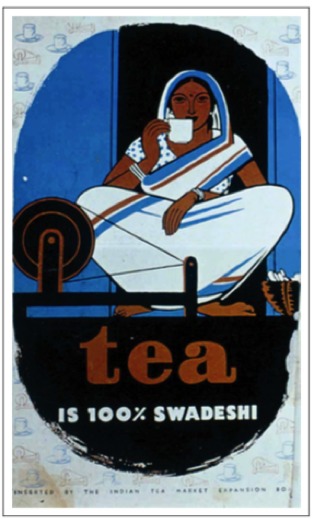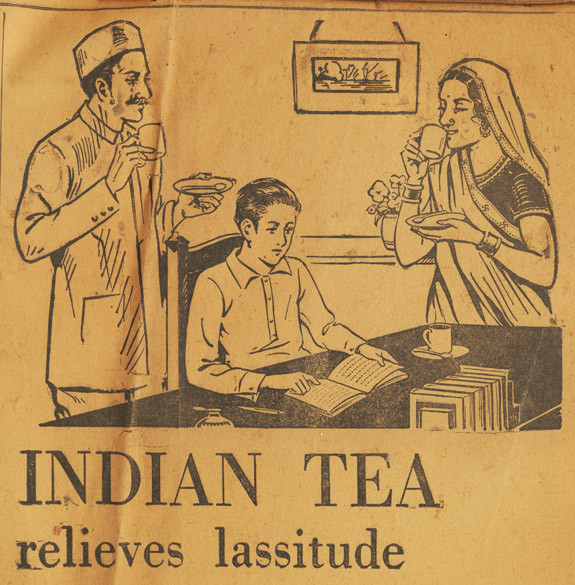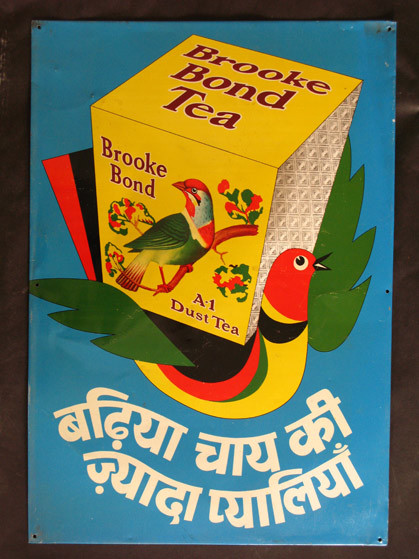Indian Tea Advertisements from during Independence
After decades of colonial rule, around the ‘late 1930s Britain and India had been drifting slowly towards an amicable parting of ways,’ (Metcalf & Metcalf, 203) as Barbara and Thomas Metcalf explain in their work A Concise History of Modern India. A variety of factors, including the growing dominance of economic nationalism around the world, caused Britain’s ‘stake in India to decline.’ (Metcalf & Metcalf, 203) The final nail in the coffin for this deteriorating relationship was the onset of WWII as the British forcibly enrolled India to fight against Hitler’s Germany alongside Britain. This sparked widespread protest as Indian people, often led by organized nationalist groups such as the Muslim League, fought against what the Metcalfs defined as ‘high handed British imperialism.’ (Metcalf & Metcalf, 203) Even after the war had ended, there was no going back. Protest, war and calls for independence swept the country and on August 15th, 1947, a new Prime Minister had been elected and announced India’s freedom. The independence movement was not as clear cut or straightforward as it appears. The nation was split in two: into the Union of India and the Dominion of Pakistan. From 1947 onward, the country that the British had once called ‘the jewel in the crown of the British Empire’ did not exist in the same way.
This poster, 'Tea is 100% Swadeshi' was produced in 1947, the same year that India gained its independence from Great Britain. This point is extremely clear from the source as it declares 'Tea is 100% Swadeshi,' with the word 'Swadeshi' meaning ‘of the country’ or ‘indigenous.’ As such, this poster identifies tea as the national drink of India.
This indigenization of tea in India is a huge contrast to advertisements that show tea as being a British product. Prior to Indian Independence, Britain had full control over the tea industry and its advertisement. Therefore, this source is a very clear of example of how India used tea as a way of promoting Indian Independence and their break away from British colonial rule. The dark skin color of the woman featured in the poster also contrasts the use of dark-skinned women in the previous source. The absence of a white individual in this source identifies the power and control of the dark-skinned woman in this poster, it is as if she is reclaiming the space that was previously dominated by white individuals. Therefore, this speaks directly to the nature of British colonial control and the eventual lack of it as a result of India gaining their independence in 1947.
This advertisement was produced by the Indian Tea Market Expansion Board, as indicated by the text at the bottom of the poster. The Indian Tea Market Expansion Board were integral to the establishment of tea as a national beverage. Beginning in 1936, this organization launched a campaign which sought to, as Shobna Nijhawan describes, ‘promote Indian tea as a national beverage … savoured [sic] by women, men and children to rejuvenate, replenish, and enjoy with company and in a quiet moment.’ (Najhawan, 1230) The statement ‘Tea is 100% Swadeshi’ explicitly shows this and therefore identifies this advertisement as a deliberate political statement. Furthermore, the Indian Tea Market Expansion Board’s presentation of an Indian woman simply drinking tea completely erases any reference to the production of the tea. As Nijhawan explains, ‘in placing the consumption and not production of tea at its centre, the designers of the Indian Tea Market Expansion Board imagined the nation as one of consumers and no longer one of producers enmeshed in exploitative colonial relationships.’ (Najhawan, 1230) Hence this advertisement shows a very explicit break away from India’s colonial past in an attempt to present the country as independent and successful in its own right.
This advertisement, 'Indian Tea relieves lassitude' was published in the 1940s in the newspaper The Hindustan Times. This newspaper was rooted in the Independence movement so, arguably, any advertisements it published had strong pro-Independence undertones. One can see this through the fact that there is no reference to racial hierarchies or British imperialism in the image, unlike the sources from pre-Independence India. Instead, this poster focuses on the health benefits of tea as it ‘relieves lassitude.’ However, the most important aspect of this advertisement is that it is for ‘Indian tea.’ The use of the country as an adjective, makes this source resonates directly with the previous source which declares ‘Tea is 100% Swadeshi,’ as it explicitly claims tea as an Indian drink. The image shows a contented family with parents drinking the tea, and a young boy sitting in front of an open book and a cup of tea.
The Hindustan Times was an English-language newspaper established in 1924 with the intentions of ‘reach[ing] an audience other than the Punjabi-reading one.’ (HTMedia) From the outset the newspaper was set up to oppose the British, … it … was inaugurated by Mahatma Gandhi … [and became] a premier nationalist newspaper of the capital in the turbulent years preceding independence.’ (HTMedia) Taking this into account, this advertisement can be analyzed according to its roots in the context of independence.
This source is particularly difficult to analyze in relation to what it is advertising and/or who it is advertising for. There is no mention of a brand name anywhere on the advertisement. Furthermore, the focus of the advertisement seems to be on the family and the health benefits of the tea, rather than any specific type of tea. Therefore, it is reasonable to assume – taking into consideration the anti-British background of the newspaper – that this advertisement is not advertising tea, it is advertising India through tea.
This source identifies a stark change in advertisement methods as time from Indian Independence moved on. This advertisement differs from others in this time period because it completely removes the role of the individual from the image. This advertisement was produced by Brooke Bond Tea company around the 1960s-1970s, thus approximately two decades after Indian Independence. This therefore mirrors the source ‘Lipton’s Tea: The Connoisseur’s Choice’ from pre-independence times as it also removed the role of the individual from the advertisement as time from when Britain had ultimate, unwavering power in India, moved on. This therefore speaks to how movement in time from important historical events are somehow related to what is presented in advertisements. The main question is, what does this mean for this source? The lack of people in this advertisement may be due to a conscious decision on behalf of the producer to move away from a deliberate claiming of Indian identity through tea. Arguably, two decades after independence a lot of the work of the independence movement had been done, advertisers did not need to actively identify tea as an India drink in order to assert their independence. This is particularly interesting when you think of the purpose of advertising – to appeal to consumers so the buy your product. Perhaps there was less demand for or discourse around Indian identity and claiming of independence and therefore a company would not need to advertise in order to appeal to those demands or interests.
Although there are no people in this image, there are bright colors, images of birds, the image of the tea box product and text at the bottom saying, ‘more cups of good tea.' (Argawal) The bright colors and birds may have been chosen for aesthetic purposes, showing that instead of presenting socio-political rhetoric or images – as we have seen in all of the previous advertisements – Brooke Bond Tea wanted to advertise the product by making it desirable. Furthermore, the image of the tea box indicates that Brooke Bond were specifically advertising the physical product, rather than any greater socio-political message. Out of this exhibit’s collection, this is the first advertisement which pictures the product that it is intending to sell. Perhaps this shows a deliberate move away from explicit political messages concerning independence and British imperialism, and instead focuses on marketing a product to the Indian people. This argument is substantiated by the statement ‘more cups of good tea’ which markets just the product itself as being ‘good.’ This contrasts the previous source which focuses on the qualities of the tea it is advertising but confounds this with the fact that it is Indian tea, thus making a clear political message.
Brooke Bond Tea Company originated in the UK in the mid-late 19th century. In 1903, the company launched its product in the Indian Market, ‘the brand soon became a market leader and enjoyed almost monopoly until the late 70’s.' (Rajagopal, 71) Although this was a British company, its endured success in India shows that the marketing techniques that the company were using were successful. It is clear that this advertisement has a pro-India message, perhaps implying that the branch of the Brooke Bond Company in India was run by Indian people, or it shows that British companies were indifferent towards politics concerning India’s independence from Britain and focused purely on making money.



